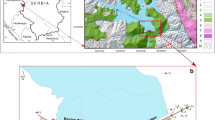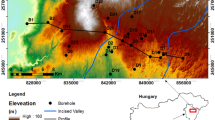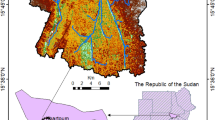Abstract
A multivariate statistical method is presented for providing hydrogeological information on groundwater formations. Factor analysis is applied to borehole logs in Hungary and the USA to estimate the vertical distribution of hydraulic conductivity of rocks intersected by the borehole. Earlier studies showed a strong correlation between a statistical variable extracted by factor analysis and shale volume in primary porosity rocks. Hydraulic conductivity as a related quantity can be derived directly by factor analysis. In the first step, electric and nuclear logs are transformed into factor logs, which are then correlated to hydraulic properties of aquifers. It is shown that a factor explaining the major part of variance of the measured variables is inversely proportional to hydraulic conductivity. By revealing the regression relation between the above quantities, an estimate for hydraulic conductivity can be given along the entire length of the borehole. Synthetic modeling experiments and field cases demonstrate the feasibility of the method, which can be applied both in primary and secondary porosity aquifers. The results of factor analysis show consistence with those of the Kozeny-Carman method and hydraulic aquifer tests. The application of the statistical analysis of well logs together with independent ground geophysical and hydrogeological methods serves a more efficient exploration of groundwater resources.
Résumé
Une méthode statistique multivariée est présentée pour fournir de l’information hydrodynamique sur des formations hydrogéologiques. L’analyse factorielle est appliquée à des diagraphies de forage de Hongrie et des USA pour estimer la distribution verticale de la conductivité hydraulique des roches recoupées par le forage. Des études antérieures ont montré une forte corrélation entre la variable statistique extraite par analyse factorielle et le volume d’argile présent dans la porosité primaire des roches. La conductivité hydraulique en tant que quantité relié à ce volume d’argile peut être directement déduite par analyse factorielle. En première étape, les diagraphies électriques et nucléaires sont transformées en logs factoriels, qui sont ensuite corrélés aux propriétés hydrodynamiques des aquifères. Il est montré que le facteur expliquant la majeure partie de la variance des variables mesurées est inversement proportionnel à la conductivité hydraulique. En révélant la relation de régression entre les paramètres définis ci-dessus, une évaluation de la conductivité hydraulique peut être donnée sur toute la longueur du forage. Des expériences de modélisation synthétique et des cas de terrain démontrent la faisabilité de la méthode qui peut être appliquée aussi bien aux aquifères à porosité de type primaire que secondaire. Les résultats de l’analyse factorielle sont cohérents avec ceux de la méthode de Kozeny-Carman et des essais hydrauliques d’aquifère. La combinaison de l’analyse statistique de diagraphies de forages avec des méthodes géophysiques et hydrogéologiques de terrain permet une plus efficace exploration des ressources en eau souterraine.
Resumen
Se presenta un método estadístico multivariado para proporcionar información hidrogeológica en formaciones de agua subterráneas. El análisis factorial se aplica a registros de perforaciones en Hungría y los EEUU para estimar la distribución hidráulica vertical de la conductividad hidráulica de rocas intersectadas por la perforación. Estudios anteriores mostraron una fuerte correlación entre una variable estadística extraída por análisis factorial y el volumen de arcilla en rocas de porosidad primaria. La conductividad hidráulica como una cantidad relacionada se puede derivar directamente por el análisis factorial. En el primer paso, los registros eléctricos y nucleares se transforman en registros factoriales, que luego se correlacionan con las propiedades hidráulicas de los acuíferos. Se muestra que un factor que explica la mayor parte de la varianza de las variables medidas, es inversamente proporcional a la conductividad hidráulica. Al ponerse de manifiesto la relación de regresión entre las cantidades anteriores, una estimación para la conductividad hidráulica ser puede dar a lo largo de toda la longitud de la perforación. Experimentos de modelado sintético y casos de campo demuestran la factibilidad del método, que puede ser aplicada tanto en acuíferos de porosidad primaria como de secundaria. Los resultados del análisis factorial muestran la consistencia con aquellos del método Kozeny-Carman y con los ensayos hidráulicos de acuíferos. La aplicación de los análisis estadísticos de registros de pozos junto con métodos hidrogeológicos y geofísicos de superficie independientes sirve a una más eficiente exploración de los recursos de agua subterránea.
摘要
本文展示了提供地下水地层水文地质信息的多元统计方法。在匈牙利和美国对钻孔记录采用因子分析法估算了钻孔岩层的水力传导率的垂直分布。较早的研究结果显示因子分析法得出的统计变量和原生孔隙岩层中的页岩量强相关。水力传导率作为一个相关的量可直接从因子分析法得出。首先,电和核记录要转换成因子记录,然后与含水层的水力特性进行对比。结果显示,说明被测变量差异主要部分的因子与水力传导率成反比。通过揭示上述两个量之间的回归关系,就可得出整个钻孔的水力传导率估算值。综合模拟实验和现场实例展示了方法的可行性,该方法可以应用于原生和次生孔隙度含水层。因子分析法结果显示,该法与Kozeny-Carman法和水力含水层实验得出的结果一致。井记录统计分析法与单独的大地地球物理法和水文地质法一起应用可大大提高地下水资源勘查的效率。
Kivonat
A tanulmányban egy többváltozós statisztikai módszert mutatunk be, mellyel hidrogeológiai információkat nyerhetünk a felszín alatti víztároló formációkról. Magyarországi és USA-beli karotázs szelvényeken faktor analízist alkalmazunk a fúrással harántolt kőzetek szivárgási tényezője vertikális eloszlásának becslése céljából. Korábbi tanulmányainkban erős korrelációt mutattunk ki egy faktor analízissel előállított statisztikai változó és az agyagtartalom között elsődleges porozitással rendelkező kőzetek esetén. A szivárgási tényező, mint agyagtartalomtól függő mennyiség a faktor analízissel közvetlenül is származtatható. Első lépésként elektromos és nukleáris szelvényeket transzformálunk faktor szelvényekké, melyeket a vízadók hidraulikai tulajdonságaival hozunk kapcsolatba. Bemutatjuk, hogy a mért változók varianciájának legnagyobb részét magyarázó faktor fordítottan arányos a szivárgási tényezővel. Feltárva a fenti mennyiségek közötti regressziós kapcsolatot, becslés adható a szivárgási tényezőre a fúrólyuk teljes hossza mentén. Szintetikus modellezési kísérletek és mezőbeli alkalmazások mutatják a módszer megvalósíthatóságát, mely mind elsődleges, mind másodlagos porozitású vízadó rétegekben alkalmazható. A faktor analízis eredményei egyezőséget mutatnak a Kozeny-Carman módszerrel meghatározott és a vízadó rétegek hidraulikai tesztjeiből származó eredményekkel. A fúrólyukszelvények statisztikai elemzésének a független felszíni geofizikai és hidrogeológiai módszerekkel együtt történő alkalmazása a felszín alatti vízkészletek még hatékonyabb kutatását biztosítja.
Resumo
É apresentado um método estatístico multivariado para fornecer informação hidrogeológica sobre formações aquíferas. É aplicada análise fatorial a perfis de sondagem na Hungria e nos EUA para estimar a distribuição vertical de condutividade hidráulica das rochas intersetadas pela sondagem. Os primeiros estudos mostram uma forte correlação entre uma variável estatística extraída por análise fatorial e o volume de xisto em rochas de porosidade primária. A condutividade hidráulica, como quantidade relativa, pode ser derivada diretamente por análise fatorial. Num primeiro passo, perfis elétricos e nucleares são transformados em perfis fatoriais, os quais são depois correlacionados com as propriedades hidráulicas dos aquíferos. Mostra-se que um fator que explica a maior parte da variância das varáveis medidas é inversamente proporcional à condutividade hidráulica. Ao revelar a relação de regressão entre as quantidades acima descritas, pode ser dada uma estimativa para a condutividade hidráulica ao longo de toda a extensão do poço. Experiências sintéticas de modelação e casos de campo demonstram a viabilidade do método, o qual pode ser aplicado tanto em aquíferos de porosidade primária como secundária. Os resultados da análise fatorial mostram consistência com os dos métodos de Kozeny-Carman e de ensaios de caudal. A aplicação de análise estatística de perfis de sondagem, em conjunto com métodos geofísicos e hidrogeológicos independentes, melhora e torna mais eficiente a exploração dos recursos hídricos subterrâneos.








Similar content being viewed by others

References
Alberty MW, Hashmy KH (1984) Application of ULTRA to log analysis. Paper Z, SPWLA 25th Annual Logging Symposium, New Orleans, LA, 10–13 June 1984, pp 1–17
Alger RP (1966) Interpretation of electric logs in fresh water wells in unconsolidated formations. SPWLA 7th Annual Logging Symposium, Tulsa, OK, 9–11 May 1966, pp 1–25
Alger RP, Harrison CW (1989) Improved fresh water assessment in sand aquifers utilizing geophysical well logs. Log Anal 30(1):31–44
Asfahani J (2014) Statistical factor analysis technique for characterizing basalt through interpreting nuclear and electrical well logging data (case study from southern Syria). Appl Radiat Isot 84:33–39
Bartlett MS (1950) Tests of significance in factor analysis. Br J Psychol 3(2):77–85
Bartlett M S (1953) Factor analysis in psychology as a statistician sees it. Nordisk Psykologi’s Monograph Series 3, Almqvist and Wiksell, Uppsala, Sweden, pp 23–34
Bear J (1972) Dynamics of fluids in porous media. Dover, New York
Benson CH, Trast JM (1995) Hydraulic conductivity of thirteen compacted clays. Clay Clay Miner 43(6):669–681
Buffin A (1996) Permeability from waveform sonic data in the Otway basin. SPWLA 37th Annual Logging Symposium, New Orleans, LA, 16–19 June 1996, pp 1–11
Csókás J (1995) Determination of water discharge and quality using geophysical well logs (in Hungarian). Magyar Geofiz 35(4):176–203
Dobróka M, Gyulai Á, Ormos T, Csókás J, Dresen L (1991) Joint inversion of seismic and geoelectric data recorded in an underground coal mine. Geophys Prospect 39:643–665
Drahos D (2005) Inversion of engineering geophysical penetration sounding logs measured along a profile. Acta Geodetica Geophys Hung 40:193–202
Dunning CP, Yeskis DJ (2007) Lithostratigraphic and hydrogeologic characteristics of the Ordovician Sinnipee Group in the vicinity of Waupun, Fond du Lac County, WI, 1995-96. US Geol Surv Sci Invest Rep 2007–5114, 51 pp
Glover PWJ, Walker E (2009) Grain-size to effective pore-size transformation derived from electrokinetic theory. Geophysics 74(1):E17–E29
Guérin R (2005) Borehole and surface-based hydrogeophysics. Hydrogeol J 13:251–254
Hvorslev MJ (1951) Time lag and soil permeability in ground-water observations. Bulletin 36, Waterways Experimentation Station, US Army Corps of Engineers, Vicksburg, MI
Idrysy EHE, De Smedt F (2007) A comparative study of hydraulic conductivity estimations using geostatistics. Hydrogeol J 15:459–470
Jöreskog KG (1969) A general approach to confirmatory maximum likelihood factor analysis. Psychometrika 34(2):183–202
Jöreskog KG (2007) Factor analysis and its extensions. In: Cudeck R, MacCallum RC (eds) Factor analysis at 100: historical developments and future directions. Erlbaum, Hillsdale, NJ
Juhász J (2002) Hydrogeology (in Hungarian). Akadémiai Kiadó, Budapest
Kaiser HF (1958) The varimax criterion for analytical rotation in factor analysis. Psychometrika 23:187–200
Khalil MA, Ramalho EC, Monteiro Santos FA (2011) Using resistivity logs to estimate hydraulic conductivity of a Nubian sandstone aquifer in southern Egypt. Near Surf Geophys 9(4):349–355
Larionov VV (1969) Radiometry of boreholes (in Russian). Nedra, Moscow
Lawley DN, Maxwell AE (1962) Factor analysis as a statistical method. Statistician 12:209–229
Odong J (2013) Evaluation of empirical formulae for determination of hydraulic conductivity based on grain-size analysis. Int J Agric Environ 1:1–8
Perdomo S, Ainchil JE, Kruse E (2014) Hydraulic parameters estimation from well logging resistivity and geoelectrical measurements. J Appl Geophys 105:50–58
Ross J, Ozbek M, Pinder GF (2007) Hydraulic conductivity estimation via fuzzy analysis of grain size data. Math Geol 39:765–780
Roy J, Lubczynski M (2003) The magnetic resonance sounding technique and its use for groundwater investigations. Hydrogeol J 11:455–465
Sallam OM (2006) Aquifers parameters estimation using well log and pumping test data, in arid regions: step in sustainable development. The 2nd International Conference on Water Resources and Arid Environment, Riyadh, Saudi Arabia, 26–29 November 2006, pp 1–12
Shevnin V, Delgado-Rodríguez O, Mousatov A, Ryjov A (2006) Estimation of hydraulic conductivity on clay content in soil determined from resistivity data. Geofísica Int 45(3):195–207
Slater L (2007) Near surface electrical characterization of hydraulic conductivity: from petrophysical properties to aquifer geometries—a review. Surv Geophys 28:169–197
Szabó NP (2011) Shale volume estimation based on the factor analysis of well-logging data. Acta Geophys 59:935–953
Szabó NP, Dobróka M (2013a) Float-encoded genetic algorithm used for the inversion processing of well-logging data. In: Michalski A (ed) Global optimization: theory, developments and applications. Mathematics Research Developments, Computational Mathematics and Analysis Series, Nova Science, New York
Szabó NP, Dobróka M (2013b) Extending the application of a shale volume estimation formula derived from factor analysis of wireline logging data. Math Geosci 45(7):837–850
Szabó NP, Kalmár CS (2013) Nonlinear regression model for permeability estimation based on acoustic well-logging measurements. Geosci Eng 2(4):27–46
Szabó NP, Dobróka M, Drahos D (2012) Factor analysis of engineering geophysical sounding data for water saturation estimation in shallow formations. Geophysics 77(3):WA35–WA44
Szabó NP, Dobróka M, Turai E, Szűcs P (2014) Factor analysis of borehole logs for evaluating formation shaliness: a hydrogeophysical application for groundwater studies. Hydrogeol J 22:511–526
Timur A (1968) An investigation of permeability, porosity, and residual water saturation relationships. SPWLA-1968-J, SPWLA 9th Annual Logging Symposium, New Orleans, LA, 23–26 June 1968
Walsh D, Turner P, Grunewald E, Zhang H, Butler JJ, Reboulet E, Knobbe S, Christy T, Lane JW, Johnson CD, Munday T, Fitzpatrick A (2013) A small-diameter NMR logging tool for groundwater investigations. Groundwater 51:914–926
Wentworth CK (1922) A scale of grade and class terms for clastic sediments. J Geol 30:377–392
Acknowledgements
The research was supported by the Hungarian Scientific Research Found (project number PD 109408). The author is thankful for the support of the János Bolyai Research Fellowship of the Hungarian Academy of Sciences. Special thanks go to Charles P. Dunning PhD for permission to use the data set of Well FL-800, and Professor Mihály Dobróka for his valuable scientific advice and inspiring co-operation.
Author information
Authors and Affiliations
Corresponding author
Rights and permissions
About this article
Cite this article
Szabó, N.P. Hydraulic conductivity explored by factor analysis of borehole geophysical data. Hydrogeol J 23, 869–882 (2015). https://doi.org/10.1007/s10040-015-1235-4
Received:
Accepted:
Published:
Issue Date:
DOI: https://doi.org/10.1007/s10040-015-1235-4



